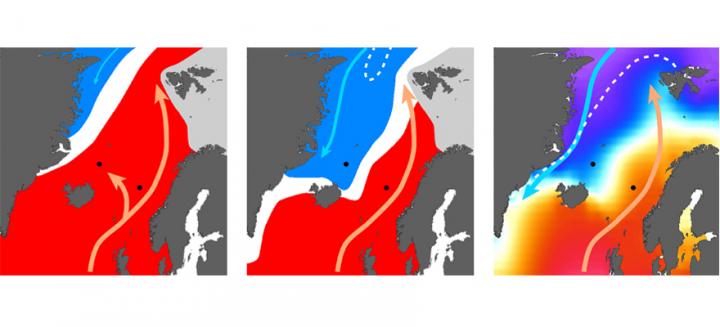Nordic seas cooled 500,000 years before global oceans

This figure shows the evolution of Nordic sea surface circulation. Credit: Stijn De Schepper
The cooling of the Nordic Seas towards modern temperatures started in the early Pliocene, half a million years before the global oceans cooled. A new study of fossil marine plankton published in Nature Communications today demonstrates this.
In the Pliocene, 5.3 to 2.6 million years ago, the world was generally warmer than today. The cooling of the oceans toward the modern situation started from 4 million years ago, but a new study now shows that the Nordic Seas cooled 500,000 year earlier.
Stijn De Schepper, researcher at Uni Research and the Bjerknes Centre for Climate research, has together with colleagues from the University of Bergen, the Alfred Wegener Institute in Germany and the Korea Polar Research Institute, investigated the fossil remains of microscopic marine plankton, especially dinoflagellate cysts, in two sediment cores from the Norwegian Sea and the Iceland Sea.
“We see that the dinoflagellate cyst assemblages underwent fundamental changes around 4.5 million years ago. Together with the simultaneous first occurrence of cool-water Pacific mollusks in Iceland, our results demonstrate that the Nordic Seas cooled significantly”, De Schepper says.
Major ocean current changes
This new study and the earlier work on migration of Pacific mollusks into the Nordic Seas suggest that the Bering Strait was open at this time, and that cool water from the Pacific flowed into the Arctic. This cool water flowed southwards along East Greenland and into the Nordic Seas, where we started to see the same temperature and circulation pattern as we have today.
Today, the Nordic Seas surface waters are characterised by an east-west temperature gradient. The southernmost part of Greenland is at the same latitude as Bergen and Oslo in Norway, but the climate in Greenland is much cooler. The warm water near Scandinavia is brought northwards via the Norwegian Atlantic Current, a continuation of the North Atlantic Current, and is today responsible for the mild winter climate along the coast of Norway. Along east Greenland a cold water current known as the East Greenland Current flows southward and transports the major part of all exported Arctic sea ice.
Thermal isolation of Greenland
“Our study shows that a surface water temperature gradient was only established since 4.5 million years ago, when warm waters continued to flow along the Scandinavian coast and cool water entered the Nordic Seas along Greenland's east coast”, De Schepper says.
In the early Pliocene the icecap on Greenland was restricted to mountain glaciers. The cool surface water that arrives from 4.5 million years ago in the western Nordic Seas isolates Greenland from the warmer water in the eastern Nordic Seas. This cool water likely leads to cooler temperatures in Greenland and the expansion of the Greenland ice sheet in the late Pliocene.
###
Reference: De Schepper, S., Schreck, M., Beck, K.M., Matthiessen, J., Fahl, K. & Mangerud. G.
Early Pliocene onset of modern Nordic Seas circulation related to ocean gateway changes.
Nature Communications 6:8659, 10.1038/ncomms9659
Media Contact
All latest news from the category: Earth Sciences
Earth Sciences (also referred to as Geosciences), which deals with basic issues surrounding our planet, plays a vital role in the area of energy and raw materials supply.
Earth Sciences comprises subjects such as geology, geography, geological informatics, paleontology, mineralogy, petrography, crystallography, geophysics, geodesy, glaciology, cartography, photogrammetry, meteorology and seismology, early-warning systems, earthquake research and polar research.
Newest articles

Innovative vortex beam technology
…unleashes ultra-secure, high-capacity data transmission. Scientists have developed a breakthrough optical technology that could dramatically enhance the capacity and security of data transmission (Fig. 1). By utilizing a new type…

Tiny dancers: Scientists synchronise bacterial motion
Researchers at TU Delft have discovered that E. coli bacteria can synchronise their movements, creating order in seemingly random biological systems. By trapping individual bacteria in micro-engineered circular cavities and…

Primary investigation on ram-rotor detonation engine
Detonation is a supersonic combustion wave, characterized by a shock wave driven by the energy release from closely coupled chemical reactions. It is a typical form of pressure gain combustion,…



